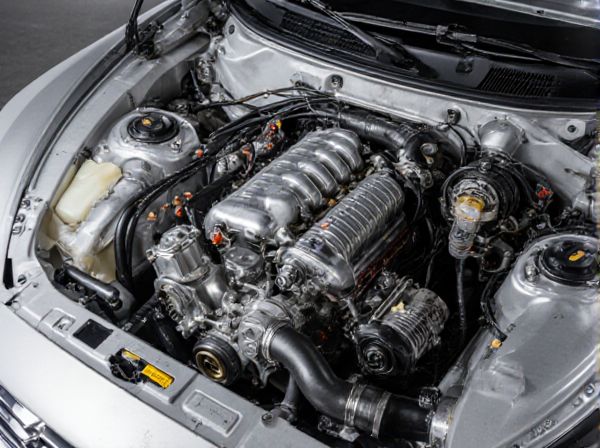
Photo illustration: Cast vs Forged Internals
Forged internals offer enhanced strength and durability compared to cast components, making them ideal for high-performance applications where your engine endures extreme stress. Cast internals, though more cost-effective, can be prone to micro-porosity and lower tensile strength, limiting their reliability under heavy loads. Choosing forged parts ensures better resistance to fatigue and deformation, providing a more robust foundation for your engine's longevity and performance.
Table of Comparison
| Feature | Cast Internals | Forged Internals |
|---|---|---|
| Material | Molten metal poured into molds | Metal shaped by high-pressure forging |
| Strength | Lower tensile strength | Higher tensile and fatigue strength |
| Durability | Prone to cracks under stress | Excellent resistance to wear and stress |
| Weight | Generally heavier | Typically lighter for same strength |
| Cost | More affordable, cost-effective | Higher manufacturing cost |
| Application | Standard engines, daily driving | High-performance, racing, tuning |
| Reliability | Sufficient for stock power levels | Superior for high-stress, boosted engines |
Understanding Engine Internals: Cast vs Forged
Engine internals, including connecting rods, pistons, and crankshafts, are manufactured either by casting or forging to balance strength, weight, and cost. Cast components are formed by pouring molten metal into molds, offering complex shapes at lower costs but generally lower strength and fatigue resistance compared to forged parts. Forged internals undergo high-pressure shaping of heated metal, resulting in denser grain structures that provide superior durability, tensile strength, and resistance to impact, making them ideal for high-performance and racing engines.
What Are Cast Engine Internals?
Cast engine internals are manufactured by pouring molten metal into molds, creating components such as pistons, cylinders, and crankshafts with intricate shapes and fine surface finishes. This casting process allows for complex geometries and cost-effective mass production, but typically results in parts with lower tensile strength and durability compared to forged counterparts. Cast engine components are commonly used in standard automotive engines where manufacturing efficiency and cost are prioritized over maximum performance and stress resistance.
What Are Forged Engine Internals?
Forged engine internals are components created by reshaping metal under intense heat and pressure, resulting in enhanced strength and durability compared to cast parts. This manufacturing process aligns the metal's grain structure, improving resistance to stress and fatigue, making forged internals ideal for high-performance engines. Typical forged components include connecting rods, pistons, and crankshafts, which are crucial for maintaining engine integrity under extreme power and RPM conditions.
Manufacturing Process: Casting vs Forging
Casting involves pouring molten metal into a mold where it solidifies, allowing for complex shapes and lower manufacturing costs but often resulting in a coarser grain structure and potential internal defects. Forging uses compressive forces to shape heated metal, producing a denser, more uniform grain flow that enhances strength, toughness, and fatigue resistance in the internal components. The manufacturing process differences directly impact mechanical properties, with forged internals typically offering superior durability compared to cast parts.
Strength and Durability Comparison
Forged internals exhibit superior strength due to the grain structure alignment achieved during the forging process, resulting in enhanced resistance to fatigue and impact stress compared to cast components. Cast internals, while more cost-effective and capable of complex shapes, typically have higher porosity and inclusions that reduce overall durability under high thermal and mechanical loads. Engineers often prefer forged parts in high-performance engines where strength-to-weight ratio and longevity under extreme conditions are critical.
Performance Differences in Engines
Forged internals offer superior strength and durability compared to cast components, enabling engines to withstand higher stress and increased power output without failure. The denser grain structure in forged parts enhances fatigue resistance and thermal conductivity, contributing to improved engine reliability and performance under extreme conditions. Cast internals, while cost-effective and suitable for moderate applications, generally exhibit lower tensile strength and are prone to micro-porosity, limiting their use in high-performance or turbocharged engines.
Cost Considerations: Cast vs Forged Parts
Cast parts generally offer lower initial manufacturing costs due to simpler tooling and the ability to produce complex shapes in a single step, making them cost-effective for high-volume production runs. Forged parts, while more expensive upfront because of higher tooling and machining expenses, provide superior strength and durability, reducing long-term maintenance and replacement costs. Evaluating total lifecycle costs including performance requirements and application stress factors is crucial when choosing between cast and forged internals.
Ideal Applications for Cast Internals
Cast internals are ideal for applications requiring complex shapes and large, intricate components that benefit from cost-effective production methods. They perform well in low to medium stress environments where dimensional accuracy and surface finish are less critical. Typical uses include pump housings, valve bodies, and equipment requiring corrosion resistance with moderate mechanical strength.
When to Choose Forged Internals
Forged internals are ideal for high-performance engines that demand superior strength and durability under extreme stress, such as racing or heavy-duty applications. They offer enhanced resistance to fatigue and impact compared to cast components, making them crucial when maximizing power output or engine longevity is a priority. Choosing forged internals is essential for builds involving high boost levels, elevated RPMs, or aggressive tuning.
Conclusion: Which Is Right for Your Build?
Choosing between cast and forged internals depends on your engine's performance goals and budget. Forged components offer superior strength and durability for high-stress applications, making them ideal for high-performance or racing builds. Cast internals provide adequate reliability at a lower cost, suitable for moderate power levels and everyday driving.
 caratoz.com
caratoz.com